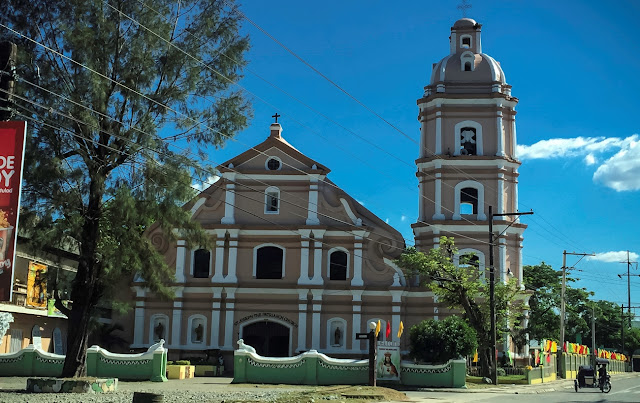THE MINOR BASILICA OF OUR LADY OF THE HOLY ROSARY OF MANAOAG
Manaoag, Pangasinan
Founded: 1600

Being near Manila, especially that the TPLEX highway has been opened, Manaoag has become the pilgrim center in the north. Every weekend thousands of devotees in buses, vans and private vehicles would flock to Manaoag causing quite a traffic in the town. The center of devotion is the Lady of the Holy Rosary, otherwise known as the Nuestra Señora de Manaoag or plainly called Apo Baket enshrined at the high altar of the church.

The feast of Our Lady of Manaoag is on the third Wednesday after Easter, and its universal feast is on the first Sunday of October. The centuries-old ivory image of Our Lady of Manaoag or “Apo Baket” which is enshrined in the high altar of the Spanish-Romanesque church is believed to be miraculous. The original icon was brought by Augustinians around 1600 to a Visita of Santa Monica (the former name of Manaoag) which they visited from Lingayen. In 1605 the Visita was turned over to the Dominicans which was served from Mangaldan. In 1610, Fr. Tomas Jimenez, OP took over the mission as the first resident priest. Due to numerous threats from Igorot raid from the nearby mountains, the community was transferred to the present site on a hill. A large church was commenced in 1701 under the sponsorship of Gaspar de Gamboa and his wife Agata Yangta, wealthy residents from Manila who transferred to Lingayen. An expansion of the church began in 1882 but was frustrated by the earthquake of 1892. The whole church with its treasures was destroyed by the fire lighted by the revolutionaries in May 1898. The miraculous image of the Virgin narrowly missed destruction. It was found abandoned behind the church and from June to October had to be kept in Dagupan for safety. Invited by Fr. Mariano Pacis, a diocesan priest of Manaoag, the Dominicans returned in 1901. Under the aegis of the Order, the church began in 1882 was finally completed to a large extent in the years 1911-1912; the central retablo was completed by the famed Tampinco studio in Manila. The transept (the arms of the church) was completed in 1931-1932. Spiritual administration of the Shrine in perpetuity was given to the Dominican Order by the Holy See in 1925. It was canonically crowned in 1926, a recognition by the Holy See of favors granted to devotees.



This Marian shrine was formally elevated to a minor basilica in solemn rites on February 17, 2015 the title being bestowed by Pope Francis on October 11, 2014. Minor or lesser basilicas are significant churches in Rome and elsewhere in the world that meet certain criteria and are given special ecclesiastical privileges. Minor basilicas are traditionally named because of their antiquity, dignity, historical value, architectural and artistic worth, and/or significance as centers of worship. A basilica must “stand out as a center of active and pastoral liturgy,” according the 1989 Vatican document Domus Ecclesiae.





Three physical signs indicate that a church is a minor basilica. The first is the presence of the Ombrellone or papal umbrella – a silk canopy designed with stripes of yellow and red, traditional papal colors. The second is the tintinnabulum or papal bell. It is mounted on a pole and carried processionally, along with the ombrellone, at the head of the clergy on special occasions. The third is the papal symbol of crossed keys which minor basilicas have the right to display on banners, on furnishings, and on the seal of the basilica. The papal seal includes the image of two crossed keys, one gold and one silver, bound with a red cord. This represents the “keys to the Kingdom of Heaven” (Mt 16:19) and is the quintessential symbol of the Papacy as an institution. Jesus’ statement to Simon Peter, “whatever you bind on earth shall be bound in heaven, and whatever you loose on earth shall be loosed in heaven” (Mt. 18:18), is understood as establishing two jurisdictions, Heaven and Earth; the silver and gold keys are said to represent these two institutions. The silver key symbolizes the power to bind and loose on Earth, and the gold key the power to bind and loose in Heaven.
 |
| A closer look of the statue of Our Lady of the Rosary enshrined at the altar. |
 |
| The Ombrellone or Papal Umbrella displayed at the altar and the Papal chair which is partly hidden. |
 |
| The Tintinnabulum or papal bell. |
 |
| The floating candle stand is found in another building where candles are lighted. |
Our Lady of Manaoag is patroness of the sick, helper of the needy, and is known for protecting crops. Numerous miracles and curative intercessions have been attributed to her. On the walls of the basilica, the more famous miracles are depicted in giant paintings such as a sick Binmaley boy who was brought back to life and a Dagupan man who was cured of throat infection.
 |
| Pilgrims milling around near the place where candles are lighted. |
 |
| At the Museum of the Shrine, we find several statues of the Our Lady of the Holy Rosary. We have here an ivory statue of Our Lady and the child Jesus. |
 |
| Another statue of the Our Lady of the Holy Rosary. |
 |
| A different statue of the Our Lady of the Holy Rosary. |
 |
| A garden within the Basilica complex. |
 |
| Several cars all lined up at the back of the church waiting to be blessed by the priests. |

























































































